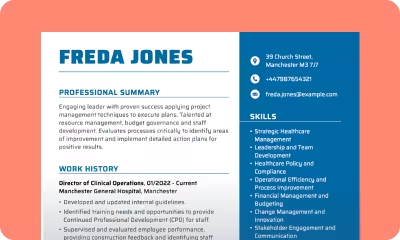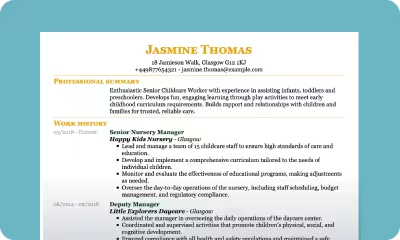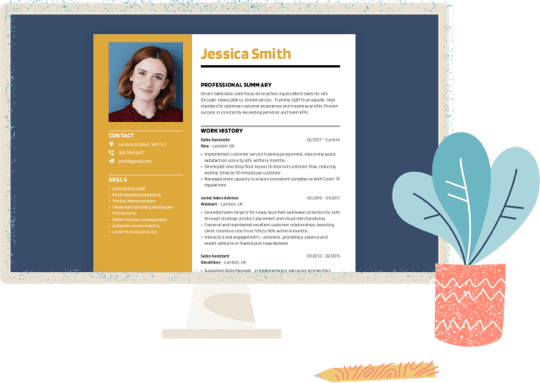- Our customers have been hired by : *Foot Note
An English CV is necessary when applying for jobs in international companies. Whether you are a recent graduate or an experienced professional looking for a job in the international market, we can help you write your English CV.
We’ve put together a selection of English CV templates, tips and frequently asked questions to help you through the CV writing process.
Once you’re ready, you can use our quick and easy English CV builder to create your own English CV – with the option to download a Word, PDF or other file types.
English CV models by job title and industry
Our templates for English CVs can be used to apply for jobs in various sectors – with a diverse range of experience levels. Take a look at some examples of our English CVs.
How to write a CV in English?
When writing a CV in English, it is crucial to follow international standards to effectively convey your skills and experience. Regardless of which country you are from, if you want to work in an international company, making changes to suit the conventions of an English CV is essential for success.
Adjusting a CV from France to an English CV
Adjusting a CV from France to an English CV involves several key considerations.
Firstly, French CVs tend to be more formal and detailed, so it’s important to translate this into clear and concise English.
Next, you need to remember to adapt the format of your CV. French CVs often follow a chronological format with detailed descriptions of each job role, whereas English CVs favour a more concise, bullet-pointed style focusing on achievements.
This detailed approach makes French CVs longer, sometimes extending to multiple pages, while English CVs are generally shorter, ideally one to two pages.
Additionally, you have to consider the cultural differences.
French CVs may emphasise academic achievements and formal qualifications, while English CVs often prioritise practical skills and work experience.
Adapting to these international standards ensures that the CV effectively showcases the candidate’s skills and experiences to English-speaking employers.
Adjusting a CV from Spain to an English CV
Similarly, adjusting a CV from Spain to an English CV involves recognising and addressing differences in language, presentation, content, and format.
Spanish CVs may use elaborate language and complex sentence structures, which need to be translated into clear and straightforward English.
While Spanish CVs might focus on loyalty to past employers and long-term career goals, whereas English CVs emphasise adaptability and readiness for change.
Not only that.
A big cultural show for international jobseekers might be that Spanish CVs often include personal details such as a photo, age, and marital status, which are typically omitted in English CVs to comply with anti-discrimination laws.
Adjusting a CV from Italy to an English CV
When adjusting a CV from Italy to an English CV key factors to consider are language, structure, design, and information covered.
Italian CVs may use formal language and honorific titles, which need to be translated into more direct and concise English.
When it comes to content, Italian CVs tend to provide extensive detail on each job role, while English CVs focus on concise bullet points highlighting key responsibilities and achievements.
Additionally, Italian CVs may include decorative elements and elaborate fonts, whereas English CVs favour a clean and professional design.
Adjusting a CV from India to an English CV
Indian CVs can be lengthy and detailed including references to family background or community involvement, which are not typically included in English CVs. While a standard English CV is 2 pages maximum, Indian CVs can cover multiple pages.
Furthermore, Indian CVs often focus heavily on academic achievements and technical skills, whereas English CVs also value soft skills, adaptability, and global experiences.
Writing a CV in your second language can be a challenging task. We want to make it easier for you. That’s why we prepared an extensive collection of prewritten content for any job title. Simply go to our CV builder and start writing your CV.
Have you translated your CV from your native language to English and now want to adjust it to international standards?
Applying with your English CV for a job in the international market
Adjusting your CV to the country-specific standards is a very important process.
After all, we all want to make the best possible impression on recruiters and employers. It turns out that while the general principles are quite similar, some countries have their own requirements.
Let’s break down some of them:
Applying with an English CV in South Africa
The South African document differs from the one used in the UK in some rather important ways. But let’s start with the similarities.
Just like in the UK, the South African CV should be no longer than two pages. It also should not include a photograph. What matters are your achievements, work ethic and education.
According to the guidelines that can be found on the government website, it should include:
- Personal details. Note: there is a little more detail here than in the UK CV. As well as your name and contact details, you will include the date and place of birth, gender, marital status, ID number, driving licence information and even your health.
- Education, including all additional courses and certificates,
- Skills, detailing computer skills and languages,
- List of awards or special achievements,
In addition to this, your CV must contain a credible references section so that your potential employer can check how you performed in your previous position.
Applying with an English CV in Australia
Forget everything we’ve told you about CVs!
The Australian Curriculum Vitae differs from the UK one in a few important ways.
Let’s start with the fact that if you have any work experience, you should apply with a 3 or even 4-page long document! A one-page CV is considered insufficient even for those new to the job market.
Include also:
- Career objective or summary, known as the personal statement. This is where you briefly outline your achievements and career goals.
- Contact details such as name, email, and telephone number.
- Work experience emphasising achievements and/or responsibilities.
- Education information.
- Skills, both transferable and technical.
- List of references along with their contact details.
Applying with an English CV in the United States
The US CV, commonly referred to as a resume, has its own distinct characteristics that set it apart from those used in other countries.
Firstly, resumes in the US are typically concise and focused, usually just one or two pages long. Unlike in some other countries, including a professional photograph is generally not recommended.
Key components to include in a US resume are:
- Contact information: Your name, phone number, and email address.
- Personal statement: A brief overview of your skills, experiences, and career goals.
- Work experience: Detailing your previous positions, focusing on accomplishments and responsibilities.
- Education: Listing your academic qualifications, degrees, and relevant certifications.
- Skills: Highlighting your key competencies and abilities relevant to the job.
- References: While not always required, it’s advisable to have a list of professional references available upon request.
Top tips for your English CV
Understand the structure
An English CV closely resembles most European CVs. It should be clear and concise, summarising your qualifications, skills, education, and work history.
English CV typically includes sections like personal statement or profile, work experience, and education.
Present these sections in reverse chronological order.
Ensure clarity and consistency
Avoid including unnecessary details like date of birth or marital status, especially in English-speaking countries.
Instead, highlight relevant achievements and responsibilities using bullet points.
Use appropriate tenses (simple past for past roles, present or present continuous for current roles).
Spelling and grammar
Be mindful of spelling and grammar differences between British and American English. Get feedback from a native speaker or use a professional tool to spellcheck, and ensure clarity, accuracy, and professionalism.
Utilise resources
Use online resources, like grammar checkers and CV makers to streamline the process and effectively showcase your qualifications and suitability for English-speaking roles.
FAQs about CVs in English
How make a CV for a job in UK English
The best approach for an English CV is to keep things simple. While you might think complex terms and jargon will impress recruiters, plain English is the best way forward. After you’ve made your CV, get an English-speaking friend or relative to read through and check for any odd phraseology and grammatical issues, along with typos and general errors. Using a pre-made English CV template will provide the right layout and structure to make things easier.
What is the correct format for a CV in English?
English CVs come in a range of formats. In the UK, the most common is the reverse-chronological, which focuses on experience with your most recent job first. There’s also the skills-based (or skill CV) in English, ideal for students or those without specific industry experience. Alternatively, for US jobs, an English resume format is preferred, which provides a brief overview of your experience and background.
How to write a CV in English for students
If you’re an overseas student in an English-speaking country, chances are you’ll need to write your CV in English. The CV itself should comprise your personal statement, work history, skills, and education. Try to highlight transferable skills from any previous roles, including communication, teamwork, and punctuality. Alternatively, with a skill CV in English, you can focus on qualities you’ve developed during your studies, such as computer literacy, meeting deadlines, and critical thinking.
Is it CV or resume in English?
The distinction between CV and resume depends on which country you’re in. In the UK, Ireland and New Zealand, CV is the correct term. Resume is used primarily in the US, where it refers to a broader, more concise overview of your working or education background. Finally, there are some English-speaking countries like India, Australia, and South Africa, where CV and resume are used interchangeable to refer to the same document – which can use the format of either a CV or resume too.
What is the full form of CV in English?
The CV full form in English is curriculum vitae. It comes from Latin, meaning “course of life”. In contrast, the term resume comes from the French “résumé” meaning “summary”. This gives a bit more context on the difference between the two documents, with CVs going into more detail, while resumes summarise an applicant’s background.
Dos and don’ts of English CVs
DO
Do use an English CV template
Using an CV template for your English CV allows you to focus on what you write, rather than having to worry about the layout and structure. Templates come pre-designed in a suitable format, with sections for your work history, skills, personal statement, and education, plus additional areas of your professional background if you’re writing an English resume.
Do get help from a native speaker
If you’re writing a CV with English as your second language, it’s good practice to find someone with English as their first language to check things over. If English isn’t your mother tongue, it’s difficult to know that certain phrases or sentence structures sound odd. Getting a friend or relative to help will root these out and make sure your CV reads well for recruiters.
DON'T
Don’t rely on a translator
Whether it’s Google translate or more advanced software, translation tools are never completely accurate. As such, they should not be relied on for your CV. While they might provide a rough idea of what you want to say, and some of the right words, the small errors will be enough for recruiters to put down your CV and move onto the next one, which brings us onto…
Don’t forget the cover letter
Writing a cover letter to accompany your English CV is a great way to sell yourself to recruiters and highlight why you think you’re a great fit for the job. Research company values and explain how you align with them, then pick out specific qualifications, skills, and experiences from your CV and describe how they make you a good fit for the job.
Try our English CV maker
From experienced project managers to ambitious entry-level applicants, English CVs are a must to take the next step in your career. Thanks to myPerfectCV, you won’t have to say “pardon my French” when you’re writing your own.
We aim to make it easier for you to create a CV in English. Word downloads, a choice of professional templates, and pre-written content that’s tailored to your job and sector – you’ll find it all on our innovative CV builder.
*The names and logos of the companies referred to above are all trademarks of their respective holders. Unless specifically stated otherwise, such references are not intended to imply any affiliation or association with myperfectCV.




